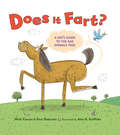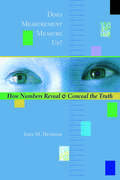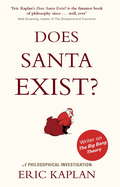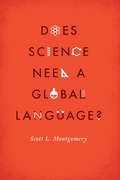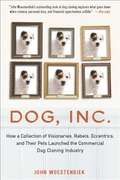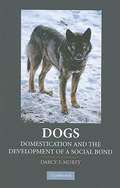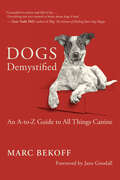- Table View
- List View
Does Anything Eat Wasps?
by New ScientistHow fat do you have to be to become bulletproof? Why do people have eyebrows? Why do pineapples have spines? How much does a head weigh? What affects the color of earwax? How quickly could I turn into a fossil?Have you ever thought up a question so completely off-the-wall, so seemingly ridiculous, that you couldn't even find the courage to ask it? Maybe at the sports bar you were transported by the beauty of your beer to wonder, "How long could I live on beer alone?" Or, cycling through the park, you mused, "Did nature invent any wheels?" Or looking up at the night sky, you had a moment of angst, "What would happen if the moon suddenly disappeared-- if it were vaporized or stolen by aliens?" Full of fun factlets,Does Anything Eat Wasps? is a runaway bestseller around the world. It celebrates the weird and wacky questions -- some trivial, some baffling, all unique -- and their multiple answers culled from "The Last Word," a long-running column in the internationally popular science magazine, New Scientist. Tackling the imponderables of everyday life, sparkling with humor, and bursting with delightful erudition, Does Anything Eat Wasps?i s irresistibly entertaining and utterly engrossing. So, go on. Put away your lab coat and your pencil -- science is fun again.
Does It Fart?: A Kid's Guide to the Gas Animals Pass
by Nick Caruso Dani Rabaiotti Alex G. GriffithsA hilariously informative book of facts, farts, and fun!Dogs fart. Cats fart. Horses fart (a lot). But what about snakes? Spiders? Octopuses? What about chimpanzees? Cheetahs? Or dinosaurs?In this gaseous guide to kids' favorite animals (and some they've probably never heard of), young readers will discover not only which animals pass gas, but also which have the stinkiest farts, which fart the most, and where all this smelly stuff comes from. They'll even learn which species has its own secret fart code! Perfect for reluctant readers, and with full-color illustrations throughout, Does It Fart? is the funniest book you never knew you needed.Based on the New York Times bestseller Does It Fart?: The Definitive Field Guide to Animal Flatulence.
Does It Fart?: The Definitive Field Guide to Animal Flatulence (Does It Fart Series #1)
by Nick Caruso Dani Rabaiotti"The book we didn't realize we needed."---Chicago ReaderDogs do it. Millipedes do it. Dinosaurs did it. You do it. I do it. Octopuses don't (and nor do octopi). Spiders might do it: more research is needed. Birds don't do it, but they could if they wanted to. Herrings do it to communicate with each other. In 2017 zoologist Dani Rabaiotti's teenage brother asked her a most teenaged question: Do snakes fart? Stumped, Rabaiotti turned to Twitter. The internet did not disappoint. Her innocent question spawned the hashtag #doesitfart and it spread like a noxious gas. Dozens of noted experts began weighing in on which animals do and don't fart, and if they do, how much, how often, what it's made of, what it smells like, and why. Clearly, the public demands more information on animal farts. Does it Fart? fills that void: a fully authoritative, fully illustrated guide to animal flatulence, covering the habits of 80 animals in more detail than you ever knew you needed. What do hyena farts smell especially bad? What is a fossa, and does it fart? Why do clams vomit but not fart? And what is a fart, really? Pairing hilarious illustrations with surprisingly detailed scientific explanations, Does it Fart? will allow you to shift the blame onto all kinds of unlikely animals for years to come.
Does Measurement Measure Up?: How Numbers Reveal and Conceal the Truth
by John M. HenshawA critical perspective of how measurements have come to affect our lives—from reasonable doubt to No Child Left Behind.There was once a time when we could not measure sound, color, blood pressure, or even time. We now find ourselves in the throes of a measurement revolution, from the laboratory to the sports arena, from the classroom to the courtroom, from a strand of DNA to the far reaches of outer space. Measurement controls our lives at work, at school, at home, and even at play. But does all this measurement really measure up? Here, John Henshaw examines the ways in which measurement makes sense or creates nonsense. Henshaw tells the controversial story of intelligence measurement from Plato to Binet to the early days of the SAT to today's super-quantified world of No Child Left Behind. He clears away the fog on issues of measurement in the environment, such as global warming, hurricanes, and tsunamis, and in the world of computers, from digital photos to MRI to the ballot systems used in Florida during the 2000 presidential election. From cycling and car racing to baseball, tennis, and track-and-field, he chronicles the ever-growing role of measurement in sports, raising important questions about performance and the folly of comparing today's athletes to yesterday's records.We can't quite measure everything, at least not yet. What could be more difficult to quantify than reasonable doubt? However, even our justice system is yielding to the measurement revolution with new forensic technologies such as DNA fingerprinting. As we evolve from unquantified ignorance to an imperfect but everpresent state of measured awareness, Henshaw gives us a critical perspective from which we can "measure up" the measurements that have come to affect our lives so greatly.
Does My Dog Love Me?: Understanding how your dog sees the world
by Graeme HallNow a Sunday Times bestsellerHave you ever wondered what your dog is really thinking?Our dogs mean the world to us and as owners we do our best to make sure they feel happy and loved, whilst also keeping them in line when needed. But wouldn’t it be so much easier if we spoke the same language and could ask what they were thinking or feeling?In his latest book, top dog trainer, Graeme Hall, reveals the secrets to understanding what your furry companion is trying to say and how they see the world. Drawing on 15 years of experience training over 5,000 dogs, and backed up with scientific evidence, he tackles all the tricky questions you’ve ever wanted to ask, such as ‘how do I tell my dog he’s been naughty?’ and ‘how long does a dog remember?’.Sharing his own personal stories and practical tips, Graeme demonstrates how to interpret your dog's body language and use that knowledge to build a stronger, more rewarding relationship, as well as how to avoid common mistakes. Whether you're a seasoned dog owner or a new pup parent, this book will change the way you think about your four-legged best friend.
Does Santa Exist?: A Philosophical Investigation
by Eric KaplanMetaphysics isn't ordinarily much of a laughing matter. But in the hands of acclaimed comedy writer and scholar Eric Kaplan, a search for the truth about old St. Nick becomes a deeply insightful, laugh-out-loud discussion of the way some things exist but may not really be there. Just like Santa and his reindeer. Even after we outgrow the jolly fellow, the essential paradox persists: There are some things we dearly believe in that are not universally acknowledged as real. In Does Santa Exist? Kaplan shows how philosophy giants Bertrand Russell and Ludwig Wittgenstein strove to smooth over this uncomfortable meeting of the real and unreal - and failed. From there he turns to mysticism's attempts to resolve such paradoxes, surveying Buddhism, Taoism, early Christianity, Theosophy and even the philosophers at UC Berkeley under whom he studied. Finally, this brilliant comic writer alights on - surprise! - comedy as the ultimate resolution of the fundamental paradoxes of life, using examples from The Big Bang Theory, Monty Python's cheese shop and many other pop-culture sources. Kaplan delves deeper into what all this means, from how our physical brains work to his own personal confrontations with life's biggest questions: If we're all going to die, what's the point of anything? What is a perfect moment? What can you say about God? Or Santa?
Does Science Need a Global Language?: English and the Future of Research
by Scott L. MontgomeryIn early 2012, the global scientific community erupted with news that the elusive Higgs boson had likely been found, providing potent validation for the Standard Model of how the universe works. Scientists from more than one hundred countries contributed to this discovery—proving, beyond any doubt, that a new era in science had arrived, an era of multinationalism and cooperative reach. Globalization, the Internet, and digital technology all play a role in making this new era possible, but something more fundamental is also at work. In all scientific endeavors lies the ancient drive for sharing ideas and knowledge, and now this can be accomplished in a single tongue— English. But is this a good thing? In Does Science Need a Global Language?, Scott L. Montgomery seeks to answer this question by investigating the phenomenon of global English in science, how and why it came about, the forms in which it appears, what advantages and disadvantages it brings, and what its future might be. He also examines the consequences of a global tongue, considering especially emerging and developing nations, where research is still at a relatively early stage and English is not yet firmly established. Throughout the book, he includes important insights from a broad range of perspectives in linguistics, history, education, geopolitics, and more. Each chapter includes striking and revealing anecdotes from the front-line experiences of today’s scientists, some of whom have struggled with the reality of global scientific English. He explores topics such as student mobility, publication trends, world Englishes, language endangerment, and second language learning, among many others. What he uncovers will challenge readers to rethink their assumptions about the direction of contemporary science, as well as its future.
Does This Mean You'll See Me Naked?
by Robert D. WebsterA funeral director reflects on 30 years of serving the living and deceased while providing us with a behind-the-scenes story told with both empathy and humor. He attempts to assuage our curiosity and answer those questions that are uppermost in our minds when faced with death, including: * How do you handle the loss of a loved one? * What really happens during a death call? * Why do people send flowers? * What occurs during the restoration process? * What do people leave in loved ones' caskets? * How has the undertaker's role evolved? * And much more...
Does Your Family Make You Smarter?
by James R. FlynnDoes your family make you smarter? James R. Flynn presents an exciting new method for estimating the effects of family on a range of cognitive abilities. Rather than using twin and adoption studies, he analyses IQ tables that have been hidden in manuals over the last 65 years, and shows that family environment can confer a significant advantage or disadvantage to your level of intelligence. Wading into the nature vs. nurture debate, Flynn banishes the pessimistic notion that by the age of seventeen, people's cognitive abilities are solely determined by their genes. He argues that intelligence is also influenced by human autonomy - genetics and family notwithstanding, we all have the capacity to choose to enhance our cognitive performance. He concludes by reconciling this new understanding of individual differences with his earlier research on intergenerational trends (the 'Flynn effect') culminating in a general theory of intelligence.
Dog Body, Dog Mind: Exploring Canine Consciousness and Total Well-being
by Michael W. FoxWith extraordinary insight and vision, veterinarian and animal behaviorist Dr. Fox explores the minds and hearts of dogs. Dogs, and all animals, have much to teach their human companions, if only humans knew how to listen. In Dog Body/Dog Mind, Fox seeks to enhance readers' understanding and communication with their canine companions. He helps readers become more fluent in "dog speak," and to understand what dogs feel, think, and want, strengthening the dog-human bond. Better communication leads to happier dogs and people. Fox also offers a holistic approach to companion animal care and preventive medicine, as well as behavioral advice and training tips that will help guarantee a healthy and happy animal.
Dog Days, Raven Nights
by John M. Marzluff Colleen MarzluffTwenty years ago, fresh out of graduate school and recently married, John and Colleen Marzluff left Arizona for a small cabin in the mountains of western Maine. Their mission: to conduct the first-ever extensive study of the winter ecology of the Common Raven under the tutelage of biologist Bernd Heinrich. Drawing on field notes and personal diaries, they vividly and eloquently chronicle their three-year endeavor to research a mysterious and often misunderstood bird--assembling a gigantic aviary, climbing sentry trees, building bird blinds in the forest, capturing and sustaining 300 ravens as study subjects, and enduring harsh Maine winters in pursuit of their goal. They also shared the unique challenges and joys of raising, training, and racing the sled dogs that assisted them in their work. Accompanied by Evon Zerbetz's lovely linocut illustrations, Dog Days, Raven Nightsis a fascinating, behind-the-scenes look at the adventures of field science and an insightful exploration of the nature of relationships, both animal and human.
Dog Is Love: Why and How Your Dog Loves You
by Clive D.L. Wynne“Lively and fascinating... The reader comes away cheered, better informed, and with a new and deeper appreciation for our amazing canine companions and their enormous capacity for love.”—Cat Warren, New York Times best-selling author of What the Dog Knows Does your dog love you? Every dog lover knows the feeling. The nuzzle of a dog’s nose, the warmth of them lying at our feet, even their whining when they want to get up on the bed. It really seems like our dogs love us, too. But for years, scientists have resisted that conclusion, warning against anthropomorphizing our pets. Enter Clive Wynne, a pioneering canine behaviorist whose research is helping to usher in a new era: one in which love, not intelligence or submissiveness, is at the heart of the human-canine relationship. Drawing on cutting‑edge studies from his lab and others around the world, Wynne shows that affection is the very essence of dogs, from their faces and tails to their brains, hormones, even DNA. This scientific revolution is revealing more about dogs’ unique origins, behavior, needs, and hidden depths than we ever imagined possible. A humane, illuminating book, Dog Is Love is essential reading for anyone who has ever loved a dog—and experienced the wonder of being loved back.
Dog Parasites Endangering Human Health (Parasitology Research Monographs #13)
by Heinz Mehlhorn Christina StrubeThis book presents the latest information on canine parasites with zoonotic potential, to help avoid human infections. Compiled by international specialists, it covers protozoa, ectoparasites and helminth species of clinical importance in dogs, as well as the state of the art in diagnosis, preventive measures and potentially necessary treatment schemes. Dogs are commonly kept in families around the world and can predispose their human companions to disease. Updating and deepening insights from other specialist literature, the book is intended for practitioners and scientists alike. It also offers practical guidance for veterinary and human physicians and highlights unexplored research areas, making it a valuable resource for students and educated non-experts with an interest in parasitology, infectiology and zoonotic pet diseases.
Dog Sense
by John BradshawDogs have been mankind's faithful companions for tens of thousands of years, yet today they are regularly treated as either pack-following wolves or furry humans. The truth is, dogs are neither--and our misunderstanding has put them in serious crisis. What dogs really need is a spokesperson, someone who will assert their specific needs. Renowned anthrozoologist Dr. John Bradshaw has made a career of studying human-animal interactions, and in Dog Sense he uses the latest scientific research to show how humans can live in harmony with--not just dominion over-- their four-legged friends. From explaining why positive reinforcement is a more effective (and less damaging) way to control dogs' behavior than punishment to demonstrating the importance of weighing a dog's unique personality against stereotypes about its breed, Bradshaw offers extraordinary insight into the question of how we really ought to treat our dogs.
Dog Sense
by John BradshawDogs have been mankind's faithful companions for tens of thousands of years, yet today they are regularly treated as either pack-following wolves or furry humans. The truth is, dogs are neither--and our misunderstanding has put them in serious crisis. What dogs really need is a spokesperson, someone who will assert their specific needs. Renowned anthrozoologist Dr. John Bradshaw has made a career of studying human-animal interactions, and in Dog Sense he uses the latest scientific research to show how humans can live in harmony with--not just dominion over-- their four-legged friends. From explaining why positive reinforcement is a more effective (and less damaging) way to control dogs' behavior than punishment to demonstrating the importance of weighing a dog's unique personality against stereotypes about its breed, Bradshaw offers extraordinary insight into the question of how we really ought to treat our dogs.
Dog Sense: How the New Science of Dog Behavior Can Make You A Better Friend to Your Pet
by John BradshawDogs have been mankind's faithful companions for tens of thousands of years, yet today they are regularly treated as either pack-following wolves or furry humans. The truth is, dogs are neither--and our misunderstanding has put them in serious crisis. What dogs really need is a spokesperson, someone who will assert their specific needs. Renowned anthrozoologist Dr. John Bradshaw has made a career of studying human-animal interactions, and in Dog Sense he uses the latest scientific research to show how humans can live in harmony with--not just dominion over-- their four-legged friends. From explaining why positive reinforcement is a more effective (and less damaging) way to control dogs' behavior than punishment to demonstrating the importance of weighing a dog's unique personality against stereotypes about its breed, Bradshaw offers extraordinary insight into the question of how we really ought to treat our dogs.
Dog, Inc.
by John WoestendiekWhat Stiff did for the dead and Fast Food Nation did for the burger, Dog, Inc. does for the stranger-than-fiction world of commercial dog cloning. It all began with a pit bull named Booger. Former Miss Wyoming Bernann McKinney was so distraught over the death of her dog, whom she regarded as her guardian and savior, that she paid $50,000 to RNL Bio for the chance to bring her beloved companion back to life. The result was a litter of five Boogers-the first successful commercial cloning of a canine-delivered in 2008, along with a slew of compelling questions about the boundaries of science, commerce, and ethics. Blending shocking investigative reporting with colorful anecdotes, Pulitzer Prize-winning John Woestendiek takes readers behind the scenes of this emerging industry.But Dog, Inc. isn't just a book about pets. Nor is it just a book about science. Rather it's a fascinating look at how our emotional needs are bending the reaches of science and technology, as well as a study of this uncharted territory.
Dog, Inc.
by John WoestendiekWhat Stiff did for the dead and Fast Food Nation did for the burger, Dog, Inc. does for the stranger-than-fiction world of commercial dog cloning. It all began with a pit bull named Booger. Former Miss Wyoming Bernann McKinney was so distraught over the death of her dog, whom she regarded as her guardian and savior, that she paid $50,000 to RNL Bio for the chance to bring her beloved companion back to life. The result were five new Boogers-the first successful commercial cloning of a canine- delivered in 2008, along with a slew of compelling questions about the boundaries of science, commerce, and ethics. Blending shocking investigative reporting with colorful anecdotes, Pulitzer Prize-winning John Woestendiek takes readers behind the scenes of this emerging industry. But Dog, Inc. isn't just a book about pets. Nor is it just a book about science. Rather it's a fascinating look at how our emotional needs are bending the reaches of science and technology, as well as a study of this uncharted territory. With our pet obsession climbing to new heights and our scientific abilities even more so, this combination raises a serious concern: Are we crossing the boundary of controlling science in the name of science, in the name of love, in the name of merchandising-or a blend of all three?
Dogpedia: A Brief Compendium of Canine Curiosities (Pedia Books #9)
by Jessica PierceAn enchanting, fact-filled treasury for the dog lover in all of us, from A to ZDogpedia is your gateway into the astonishing world of dogs. Featuring dozens of alphabetical entries on topics ranging from the wonders of dog evolution to the intricate ways dogs communicate with humans and each other, this enticing, pocket-friendly collection helps you to see dogs with new eyes and celebrate the amazing tapestry of our shared existence.Explore the remarkable interplay between humans and dogs with every turn of the page and discover how dogs have played starring roles in history, literature, and art. Immerse yourself in fun facts about dog biology and behavior, from appeasement signals and barking to counter surfing, dominance, growling, scent marking, and zoomies. Learn what fossilized poop can tell us about the history of dog domestication, how dogs in Siberia evolved adaptations to help them thrive in a frigid climate, how dogs have been weaponized for war and colonization, and why we refer to dogs as curs, mutts, and hounds. Meet famous dogs such as Argos, Balto, Boji, and Laika, and marvel at the interwoven destinies of our species and the profound impact dogs have had on our evolution, culture, and everyday lives.With captivating drawings that bring the entries to life, Dogpedia uncovers the enigma of dogs, revealing hidden treasures behind every wagging tail.Features a cloth cover with an elaborate foil-stamped design
Dogs
by Darcy F. MoreyThis book traces the evolution of the dog, from its origins about 15,000 years ago up to recent times. The timing of dog domestication receives attention, with comparisons between different genetics-based models and archaeological evidence. Allometric patterns between dogs and their ancestors, wolves, shed light on the nature of the morphological changes that dogs underwent. Dog burials highlight a unifying theme of the whole book: the development of a distinctive social bond between dogs and people; the book also explores why dogs and people relate so well to each other. Though cosmopolitan in overall scope, the greatest emphasis is on the New World, with an entire chapter devoted to dogs of the arctic regions, mostly in the New World. Discussion of several distinctive modern roles of dogs underscores the social bond between dogs and people.
Dogs Demystified: An A-to-Z Guide to All Things Canine
by Marc BekoffAn all-encompassing and fun reference from an award-winning scientist and dog lover Dr. Marc Bekoff is an expert at turning cutting-edge science into practical, reader-friendly information. The encyclopedic entries in this book cover everything related to dog care, dog-human relationships, and dog behavior, cognition, and emotions, making this the accessible book that every dog lover should have. In concise, readable A-through-Z entries, Bekoff covers it all, from aggression to pack formation to zoomies, and explores why dogs do what they do; exactly how to meet any dog eye-to-eye, nose-to-nose, and ear-to-ear to understand their world better; and how tuning in to a dog’s unique personality leads to happier dogs and happier human companions.
Dogs That Know When Their Owners Are Coming Home
by Rupert SheldrakeHow do cats know when it's time to go to the vet, even before the cat carrier comes out? How do dogs know when their owners are returning home at unexpected times? How can horses find their way back to the stable over completely unfamiliar terrain?With a scientist's mind and an animal lover's compassion, world-renowned biologist Rupert Sheldrake presents a groundbreaking exploration of animal behavior that will profoundly change the way we think about animals -- and ourselves. After five years of extensive research involving thousands of people who have pets and work with animals, Dr. Sheldrake proves conclusively what many pet owners already know: there is a strong connection between humans and animals that defies present-day scientific understanding. This remarkable book deserves a place next to the most beloved and valuable books on animals, including When Elephants Weep, Dogs Never Lie About Love, and The Hidden Life of Dogs.From the Trade Paperback edition.
Dogs: Fun Facts and Amazing Stories (Awesome Animals #1)
by Dianne BatesDogs really are the perfect best friend. They are loyal, smart, fun and totally awesome! In this fabulous combination of remarkable true stories, amazing facts and lots of fun stuff, we get to discover just how incredible our canine friends really are. From stories about dogs in history, heroic dogs and working dogs to bizarre facts and wacky dog jokes, this book will entertain and make you smile. This gorgeous book also features lots of beautiful illustrations and images of the adorable dogs from Best Friends Pet Rescue.
Dogs: Their Fossil Relatives & Evolutionary History
by Xiaoming Wang Richard H. TedfordTwo noted paleontologists present a detailed portrait of the family Canidae across 40 million years of evolution in this illustrated volume. After decades of research and analysis, paleontologists Xiaoming Wang and Richard H. Tedford established the modern framework for understanding the evolutionary relationship of canids. Combining their work with Mauricio Antón's reconstructions of both extinct and extant species, Wang and Tedford now present a nuanced and visually stunning portrait of the origin and evolution of canids. The fossil record of the Canidae, particularly those from their birthplace in North America, are the strongest of their kind among known groups of carnivorans. Such a wonderfully detailed evolutionary history makes the canid an ideal model organism for the mapping of predator behavior and morphological specializations. With its innovative illustrated approach to this important branch of animal and fossil study, Dogs provides an unprecedented reference for anyone interested in the evolution of these fascinating animals.
Dogs: Their Fossil Relatives and Evolutionary History
by Xiaoming Wang Richard TedfordXiaoming Wang and Richard H. Tedford have spent the past 20 years studying the evolutionary history of the family Canidae. Both are well known for having established the modern framework for the evolutionary relationship of canids. Combining their research with Mauricio Antón's impeccable reconstructions of both extinct and extant species, Wang and Tedford present a remarkably detailed and nuanced portrait of the origin and evolution of canids over the past 40 million years. The authors cull their history from the most recent scientific research conducted on the vast collections of the American Museum of Natural History and other leading institutions. The fossil record of the Canidae, particularly those from their birth place in North America, are the strongest of their kind among known groups of carnivorans. Such a wonderfully detailed evolutionary history provides access to a natural history that is not possible with many other groups of carnivorans.With their rich fossil record, diverse adaptations to various environments, and different predatory specializations, canids are an ideal model organism for the mapping of predator behavior and morphological specializations. They also offer an excellent contrast to felids, which remain entrenched in extreme predatory specializations. The innovative illustrated approach in this book is the perfect accompaniment to an extremely important branch of animal and fossil study. It transforms the science of paleontology into a thrilling visual experience and provides an unprecedented reference for anyone fascinated by dogs.

